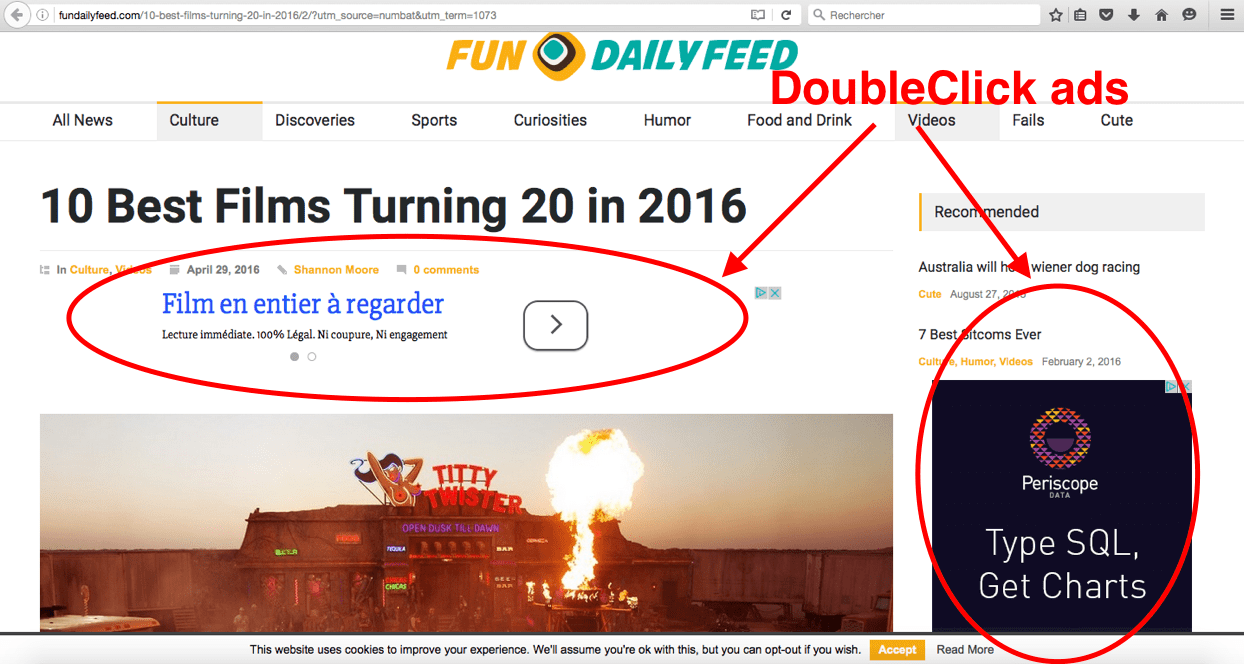Established publishers are trashing their websites with low-quality content recommendations. Bad guys gaming ad tech rules. The Web is turning into a clickbait jungle. Smartphone manufacturers and software publishers, worried about worsening browsing experience, are uniting to fight online ads. Unless ad tech starts to pay attention to the consumer, its days are numbered.
June 2, 2016
Executive Summary
Internet traffic sources have shifted from search engines to recommendation platforms. As traffic is harder to track, it becomes easier for shady websites to posture as legitimate publishers.
Traffic laundering is thriving. Bad guys have become experts at gaming ad tech metrics and monetizing fake or unwilling visitors.
Legitimate publishers themselves have turned away from Google as a source of traffic, and resorted to clickbait and traffic brokers to monetize their visitors.
Ad tech’s rules for ad placement have distorted the web so much that consumers have revolted and started using ad blockers. Smartphone manufacturers and software developers have joined the trend.
The efficiency of digital marketing has been declining for years. Unless ad tech changes its stance and becomes much more consumer-friendly, it will be responsible for its own demise.
Analysis
Internet traffic sources have shifted from search engines to recommendation platforms. As traffic is harder to track, it becomes easier for shady websites to posture as legitimate publishers.
Traffic sources have shifted from search engines to recommendation platforms. People access content less through Google that through Facebook, Twitter, and traffic brokers such as Taboola or OutBrain (Facebook has taken over from Google as a traffic source for news).
This makes traffic harder to track. Ad tech’s position is that they know who exactly is viewing the ad, so it doesn’t really matter where the viewer is coming from, or where the ad is being displayed (as long as it’s not next to adult or illegal content).
This also makes it easier for shady websites to posture as legitimate publishers. As an example, we’ve picked out toastedballs.com. It has virtually no backlinks, negligible search engine traffic, and an estimated 50 million visitors per month, most of them male. It also have remarkably little user interaction with its content. That’s what happens when you buy all of your visitors from adult website popups. They advertise with Criteo, who pays on a CPM basis. When we showed this to a friend in ad tech, he shrugged and plainly stated that Criteo doesn’t care where people come from, because Criteo trust their algorithms. The deep, fundamental problem with this approach is that Criteo finances a website with zero purpose other than to monetize porn traffic.
Traffic laundering is thriving. Bad guys have become experts at gaming ad tech metrics and monetizing fake or unwilling visitors.
As backlinks and traffic channels become harder to track, traffic laundering is thriving. Working manually, we have uncovered several networks of shell websites, that source and redirect their traffic through a dozen of private, obscure traffic brokers. Visitors are usually being redirected against their will, in popups, pop-unders, or new browser tabs.
These traffic brokers are designed to game the advertising industry’s metrics. Most of their visitors are sent to low-end websites. But if you happen to be of high value to the ad tech industry (based on your IP), you’ll be redirected through a loop of various shell websites, spending a fraction of a second on each, in order to increase the apparent quality of these websites’ audience. Once the shell websites in the network have good enough Alexa rankings, and off-the-chart demographics, they sign contracts to display ads with much better terms (Chart 1).
Most of the companies that end up advertising on these shell websites are big, established brands. The fault falls on their exclusive advertising agencies (Omnicom, Adobe, Alliance Data) that fail to detect the scheme.Chart 1:Chart 1:Mechanism of a traffic laundering scheme, from websites that can’t monetize their traffic with ads directly because their content isn’t approved (source: Kalkis Research)

Here’s the list of websites from one such traffic laundering network. Check them out on Alexa. They’ve all been created in late October – early November 2015, all their visitors come from obscure traffic brokers, and all have stale, generic content. And all have outstanding demographics: Caucasian males with high income, good education, ages between 25 and 44, coming from the US, Canada, Australia and Great Britain.
Ad dollars are being stolen from publishers who actually put in an effort to create original, useful content. This very wrong.
Legitimate publishers themselves have turned away from Google as a source of traffic, and resorted to clickbait and traffic brokers to monetize their visitors.
As traffic becomes less centralized, any single party has less influence on the way websites behave. There’s less willingness to please Google’s ranking algorithms, and more efforts to optimize for ads.
Google’s search ranking algorithms used to guide the way publishers designed their websites. The need to rank high among search results forced publishers to comply to Google’s rules. Google was a central authority that would rule what is good or bad behavior, and everyone would have to comply, or see their share of traffic tumble.
Now, as a growing share of traffic comes from social media and content recommendations, publishers focus more on flashy headlines, than on clean HTML code or legitimate backlink structure. This secular shift is embodied by the clickbait phenomenon (Chart 2).Chart 2:Chart 2: Long-term news flow for “clickbait”
- Articles
- Chart
Chart 3: Long-term news flow for “clickbait”
- Default
- 30 D
- 90 D
- 180 D
- 1 Y
- 2 Y
- 5 Y
- Articles
- Chart
Traffic brokers are one more way to monetize visitors. Big brands (such as Times Inc) have signed multi-year contracts with OutBrain and Taboola to have their recommendation banners displayed at the end of every article, hoping for regular visitors to click on that alluring celebrity gossip piece (Chart 3).Chart 4:Chart 3: News flow about content recommendation platforms
- Articles
- Chart
Chart 5: News flow about content recommendation platforms
- Default
- 30 D
- 90 D
- 180 D
- 1 Y
- 2 Y
- 5 Y
- Articles
- Chart
News flow for Outbrain, Taboola, Revcontent, Contextly, Natively11wall.st
We’ve spent a couple of days looking investigating the links Taboola displays on its banners. They are surprisingly uncorrelated to the webpage’s content, or the user’s IP. Worst of all, around half of them lead to “traffic arbitrage” wannabes: shell websites with stale and generic content, filled with ads and clickbait (table below). Some of them seem to be outright fraud, as there’s no way they could have CPRs high enough to eek out a profit after paying at least 3 cents per visitor to Taboola.
Times Inc celebrated its deal with OutBrain in November 2014, claiming it would bring in $100 million. That’s a paltry 3 cents per month and per unique visitor on their network of websites. In our opinion, the damage to the brand image when Times Inc visitors are redirected to trashy traffic arbitrage websites is much higher.
Ad tech’s rules for ad placement have distorted the web so much that consumers have revolted and started using ad blockers. Smartphone manufacturers and software developers have joined the trend.
Ad tech is fundamentally changing the structure of the Web, by incentivizing behaviors that maximize ad revenue. Website layout, links (thus, the structure of web traffic) and content are shaped by the need for publishers to make readers click on ads.
Ad tech defines automatic rules for publishers to comply with, that end up distorting the Web. When (led by Google’s AdSense) they forbade partner websites to have more than three ads per page, publishers started splitting posts into pieces, so that visitors would need to click “next” a few times to read the whole piece, and get served with more ads. This horrendous design trend was further incentivized by the need to make the bounce rate look better. Ad tech is in love with low bounce rates (percentage of users that close the website without clicking on any other link), because they believe that it’s a good measure of website quality. Now, it’s becoming a measure of horrendous user experience.
Any automatic rule that ad tech comes up with, ends up being gamed, with little regard for user experience, and with the sole objective of maximizing ad revenue. This leads to obfuscated design, and ads and external links that look a lot like own content. This particularly true for mobile ads, where close to half of ad clicks were estimated to be misclicks. This old news, but for some reason nobody looked into the problem again since 2012.
The rise of ad-blocking software is a revolt by Web users against the new shape of the Internet. If this trend continues, publishers and the ad tech industry will both suffer. There needs to be a new force to guide the evolution of the Web.
The efforts that are put in by the ad industry to circumvent ad blockers is worrisome. They focus on the symptom instead of fighting the disease: the digital marketing market is saturated, and consumers are fed up with ads. The browsing experience has deteriorated so much over the last years that smartphone manufacturers and software developers themselves have joined the trend in cleaning up the Web (Chart 4).Chart 6:Chart 4: New flow for “ad blockers” and “browsing experience”
- Articles
- Chart
Chart 7: New flow for “ad blockers” and “browsing experience”
- Default
- 30 D
- 90 D
- 180 D
- 1 Y
- 2 Y
- 5 Y
- Articles
- Chart
news flow about ad blockers in the context of worsening browsing experience11wall.st
The efficiency of digital marketing has been declining for years. Unless ad tech changes its stance and becomes much more consumer-friendly, it will be responsible for its own demise.
One of the consequences of growing consumer disgust with ads, is that ad efficiency is declining, as shown by the declining revenue for every dollar spent on advertising by the few companies who disclose it in their SEC filings (Chart 5).Chart 8:Chart 5:Dollars of revenue for every dollar spent on digital marketing, average for Amazon, Priceline, Booking.com, Expedia and Ebay (source: SEC 10-K filings 2010 through 2015, Kalkis Research)
Ad tech has focused on automatization and economies of scale, which has enabled them to place low-cost ads on the murkiest of websites, because the cost of placing an ad has become so low. This rush to subprime ad space ended up hurting the high end of the market as well, as Internet users become tired of ads in general. You can only make up for low margins with volume for so long.
In the end, consumers will make or break the digital advertising industry. Ad tech has always considered Internet users as guinea pigs in their all-numbers experiment. Tough luck, everything in our world is reflexive, and if you treat people badly for long enough, they’ll turn against you. By installing ad blockers, or by stopping clicking on ads altogether.
To save the system, Internet users should have a say in the way they’d like to be treated. They must understand that advertising is a necessary evil to keep the Internet free. It’s also a very powerful weapon to shape the Web’s development, towards cleaner designs and better content.
Roadmap & Playbook
This piece is a follow-up to our first article Google: End of the Online Advertising Bubble. Ad dollars are trashing the Web by incentivizing publishers to think short term, to maximize ad revenue and to save a few dollars to the detriment of content quality.
Clickbait has risen in line with ad tech since early 2013. It was good while it lasted, scores of companies managed to IPO and get some Wall Street cash on hopes the trend will continue forever. But then the world has turned against them, with a vengeance (Chart 6).Chart 9:Chart 6: Long term news flow for “clickbait”, “ad tech” and “ad blockers”
- Articles
- Chart
Chart 10: Long term news flow for “clickbait”, “ad tech” and “ad blockers”
- Default
- 30 D
- 90 D
- 180 D
- 1 Y
- 2 Y
- 5 Y
- Articles
- Chart
Ad blockersClickbaitAd Tech11wall.st
Advertising agencies that fail to control for publisher quality are doomed to waste their client’s money. Worse, they expose their clients to outright theft. Any system that’s defined by quantitative rules ends up being gamed by smart guys, as we’ve illustrated above. Bad guys have caught up with ad tech’s “state of the art algorithms”. Any technological advantage is short-lived, and it seems that we’re seeing the end of the user profiling miracle.
If the ad tech industry is to survive, they need to come up with a better system to evaluate the quality of ad space, and admit that Internet users can only take in so many ads. They must focus on quality, and pay the prime ad space its fair due, to incentivize good publisher behavior, and stop the money flow to guys who are in for the quick buck, to the detriment of everyone else.




